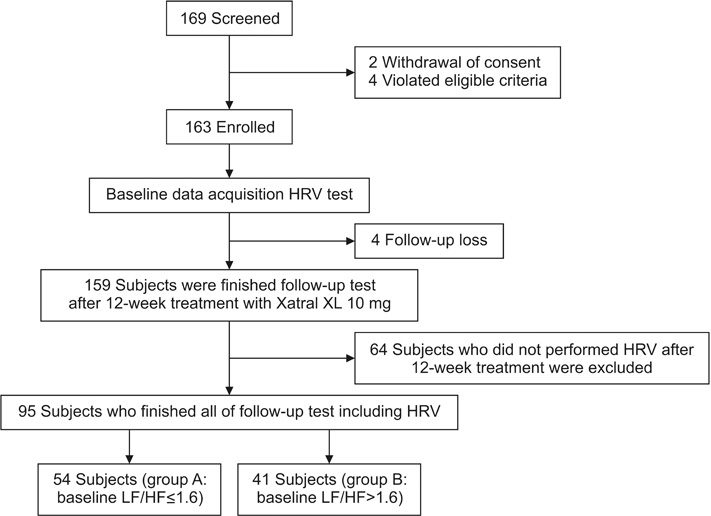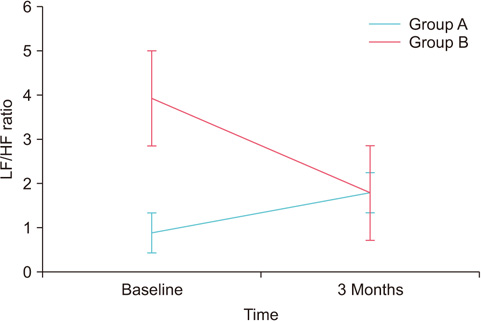Investig Clin Urol.
2018 Jan;59(1):49-54. 10.4111/icu.2018.59.1.49.
Changes in autonomic nervous system activity after treatment with alpha-blocker in men with lower urinary tract symptoms
- Affiliations
-
- 1Department of Urology, Ajou University College of Medicine, Suwon, Korea. urochoi@ajou.ac.kr
- 2Department of Urology and Urological Science Institute, Yonsei University College of Medicine, Seoul, Korea.
- 3Department of Urology, Samsung Medical Center, Sungkyunkwan University School of Medicine, Seoul, Korea.
- 4Department of Urology, Chonbuk National University School of Medicine, Jeonju, Korea.
- 5Department of Urology, Chonnam National University Medical School, Gwangju, Korea.
- 6Department of Urology, Korea University Anam Hospital, Seoul, Korea.
- 7Department of Urology, Dongguk University College of Medicine, Gyeongju, Korea.
- 8Department of Urology, Dankook University College of Medicine, Cheonan, Korea.
- 9Department of Urology, Inha University College of Medicine, Incheon, Korea.
- 10Department of Urology, Seoul National University Hospital, Seoul, Korea.
- 11Department of Urology, The Catholic University of Korea College of Medicine, Seoul, Korea.
- KMID: 2399265
- DOI: http://doi.org/10.4111/icu.2018.59.1.49
Abstract
- PURPOSE
To determine changes in autonomic nervous system activity after treatment in men with lower urinary tract symptoms (LUTS), we evaluated changes in patients' symptoms, uroflowmetry, and heart rate variability (HRV) after treatment with alpha-blockers for 12 weeks.
MATERIALS AND METHODS
Ninety-five men who had LUTS (International Prostate Symptom Score [IPSS] ≥8) were included in this study. We divided them into two groups on the basis of a low frequency/high frequency (LF/HF) ratio of 1.6. After treatment with Xatral XL (Handok Inc., Korea) 10 mg for 3 months, we rechecked their IPSS, uroflowmetry, HRV and compared these with the baseline measurements.
RESULTS
Fifty-four men were assigned to the low LF/HF group (group A: LF/HF ≤1.6) and 41 men to the high LF/HF group (group B: LF/HF >1.6). At baseline and 12 weeks, none of the parameters differed significantly between the groups except for HF, which is one of the parameters of HRV. IPSS, the IPSS-voiding subscore, and the IPSS-storage subscore decreased and maximal uroflow increased significantly after 12 weeks of treatment. Whereas the baseline LF/HF ratio increased from 0.89±0.407 to 1.80±1.804 after treatment in group A, it decreased from 3.93±5.471 to 1.79±1.153 in group B.
CONCLUSIONS
The efficacies of Xatral XL were clear in both groups. We found that the LF/HF ratio in the two groups merged to a value of approximately 1.79 after treatment. We suggest that this could be a clue to the importance of balance in autonomic nervous system activity in men with LUTS.
Keyword
MeSH Terms
Figure
Reference
-
1. Ushijima S, Ukimura O, Okihara K, Mizutani Y, Kawauchi A, Miki T. Visual analog scale questionnaire to assess quality of life specific to each symptom of the International Prostate Symptom Score. J Urol. 2006; 176:665–671.
Article2. Hubeaux K, Deffieux X, Raibaut P, Le Breton F, Jousse M, Amarenco G. Evidence for autonomic nervous system dysfunction in females with idiopathic overactive bladder syndrome. Neurourol Urodyn. 2011; 30:1467–1472.
Article3. Oh DG, Cho DS, Yun IS, Lee KB, Choi JB, Lee JH. The difference of lower urinary tract symptoms between sympathetic hyperactive and hypoactive men. Int Neurourol J. 2013; 17:30–33.
Article4. Choi JB, Lee JG, Kim YS. Characteristics of autonomic nervous system activity in men with lower urinary tract symptoms (LUTS): analysis of heart rate variability in men with LUTS. Urology. 2010; 75:138–142.
Article5. Park SG, Chung BH, Lee SW, Park JK, Park K, Cheon J, et al. Alpha-blocker treatment response in men with lower urinary tract symptoms based on sympathetic activity: prospective, multicenter, open-labeled, observational study. Int Neurourol J. 2015; 19:107–112.
Article6. Ventura S, Oliver Vl, White CW, Xie JH, Haynes JM, Exintaris B. Novel drug targets for the pharmacotherapy of benign prostatic hyperplasia (BPH). Br J Pharmacol. 2011; 163:891–907.
Article7. Roehrborn CG, Schwinn DA. Alpha1-adrenergic receptors and their inhibitors in lower urinary tract symptoms and benign prostatic hyperplasia. J Urol. 2004; 171:1029–1035.8. Miano R, De Nunzio C, Asimakopoulos AD, Germani S, Tubaro A. Treatment options for benign prostatic hyperplasia in older men. Med Sci Monit. 2008; 14:RA94–R102.9. Low PA. Testing the autonomic nervous system. Semin Neurol. 2003; 23:407–421.
Article10. Yoshimura N, Ogawa T, Miyazato M, Kitta T, Furuta A, Chancellor MB, et al. Neural mechanisms underlying lower urinary tract dysfunction. Korean J Urol. 2014; 55:81–90.
Article11. Mazur DJ, Helfand BT, McVary KT. Influences of neuroregulatory factors on the development of lower urinary tract symptoms/benign prostatic hyperplasia and erectile dysfunction in aging men. Urol Clin North Am. 2012; 39:77–88.
Article12. McVary KT, Razzaq A, Lee C, Venegas MF, Rademaker A, McKenna KE. Growth of the rat prostate gland is facilitated by the autonomic nervous system. Biol Reprod. 1994; 51:99–107.13. McVary KT, Rademaker A, Lloyd GL, Gann P. Autonomic nervous system overactivity in men with lower urinary tract symptoms secondary to benign prostatic hyperplasia. J Urol. 2005; 174:1327–1433.
Article14. Massin MM, Derkenne B, von Bernuth G. Correlations between indices of heart rate variability in healthy children and children with congenital heart disease. Cardiology. 1999; 91:109–113.
Article15. Bigger JT Jr, Fleiss JL, Steinman RC, Rolnitzky LM, Kleiger RE, Rottman JN. Frequency domain measures of heart period variability and mortality after myocardial infarction. Circulation. 1992; 85:164–171.
Article16. Akselrod S, Gordon D, Ubel FA, Shannon DC, Berger AC, Cohen RJ. Power spectrum analysis of heart rate fluctuation: a quantitative probe of beat-to-beat cardiovascular control. Science. 1981; 213:220–222.
Article17. Malliani A, Pagani M, Lombardi F, Cerutti S. Cardiovascular neural regulation explored in the frequency domain. Circulation. 1991; 84:482–492.
Article18. Appel ML, Berger RD, Saul JP, Smith JM, Cohen RJ. Beat to beat variability in cardiovascular variables: noise or music. J Am Coll Cardiol. 1989; 14:1139–1148.
Article19. Task Force of the European Society of Cardiology and the North American Society of Pacing and Electrophysiology. Heart rate variability. Standards of measurement, physiological interpretation, and clinical use. Eur Heart J. 1996; 17:354–381.20. Roehrborn CG, Van Kerrebroeck P, Nordling J. Safety and efficacy of alfuzosin 10 mg once-daily in the treatment of lower urinary tract symptoms and clinical benign prostatic hyperplasia: a pooled analysis of three double-blind, placebo-controlled studies. BJU Int. 2003; 92:257–261.
Article21. Yeo JK, Choi H, Bae JH, Kim JH, Yang SO, Oh CY, et al. Korean clinical practice guideline for benign prostatic hyperplasia. Investig Clin Urol. 2016; 57:30–44.
- Full Text Links
- Actions
-
Cited
- CITED
-
- Close
- Share
- Similar articles
-
- The Relation between Autonomic Nervous System Activity and Lower Urinary Tract Symptoms: An Analysis of Heart Rate Variability in Men with Lower Urinary Tract Symptoms
- Management of Lower Urinary Tract Dysfunction in Patients with Neurological Disorders
- Shape-up LUTS/BPH Guideline in Korea: Medical Treatment
- The Difference of Lower Urinary Tract Symptoms Between Sympathetic Hyperactive and Hypoactive Men
- Influence of Autonomic Nervous System in Occlusion and Reperfusion Arrhythmia



